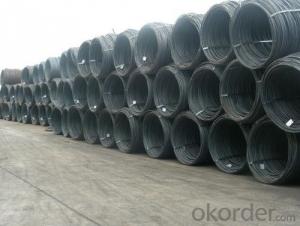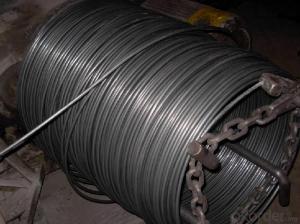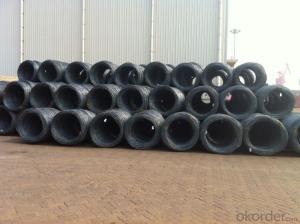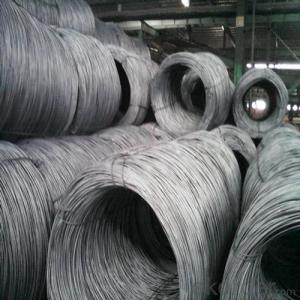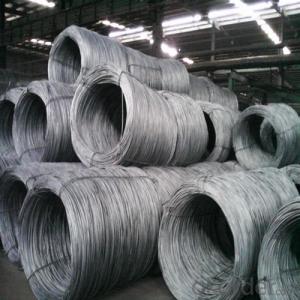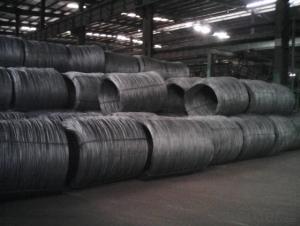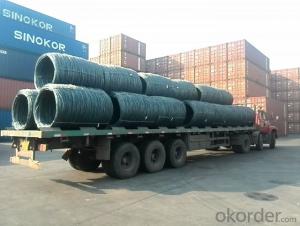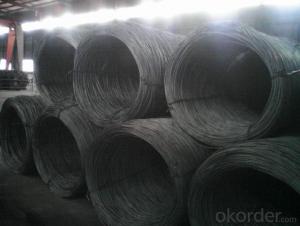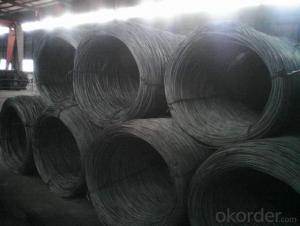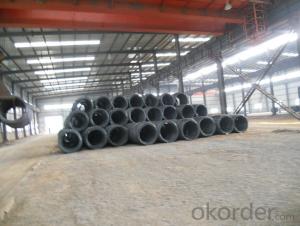Hot Rolled Steel Wire Rod SAE1008 for Making Wire and Nail
- Loading Port:
- Tianjin
- Payment Terms:
- TT or LC
- Min Order Qty:
- 25 m.t.
- Supply Capability:
- 200000 m.t./month
OKorder Service Pledge
OKorder Financial Service
You Might Also Like
Product Description:
OKorder is offering Hot Rolled Steel Wire Rod SAE1008 for Making Wire and Nail at great prices with worldwide shipping. Our supplier is a world-class manufacturer of steel, with our products utilized the world over. OKorder annually supplies products to European, North American and Asian markets. We provide quotations within 24 hours of receiving an inquiry and guarantee competitive prices.
Product Applications:
Hot Rolled Steel Wire Rod SAE1008 for Making Wire and Nail are ideal for structural applications and are widely used in the construction of buildings and bridges, and the manufacturing, petrochemical, and transportation industries.
After hot-rolled the products shaped into coil and delivery as finished product, including round, square, rectangular, hexagonal and so on. Since most of the products are round, it is generally called wire rod. Carbon steel wire rod is widely used in construction and manufacturing. Carbon steel wire rod is mainly used for reinforcement of reinforced concrete and welded structure or reprocessed (roberts , nail, etc.) materials, especially used to produce wire drawing, welding electrode, nails, spring, electronic, precise machinery parts and so on.
Product Advantages:
OKorder's Hot Rolled Steel Wire Rod SAE1008 for Making Wire and Nail are durable, strong, and resist corrosion.
Main Product Features:
· Premium quality
· Prompt delivery & seaworthy packing (30 days after receiving deposit)
· Corrosion resistance
· Can be recycled and reused
· Mill test certification
· Professional Service
· Competitive pricing
Specifications of Hot Rolled Steel Wire Rod SAE1008 for Making Wire and Nail:
Steel Grade: Q195/235, SAE1006-1018B Standard: ASTM, GB
Diameter: 5.5mm, 6.5mm, 7mm,8mm,9mm,10mm,12mm,14mm
Diameter tolerance: ±0.3mm Type: in coil, coil weight around 2MT
Technique: Hot Rolled Place of Origin: China Mainland
Surface: round, no twisted, light and smooth
Chemical Composition: (Please kindly find our chemistry of our material based on Q195、Q235A and Q235B as below for your information)
Trademark | Rank | Chemical composition (quality score) % | |||||
C | Si | Mn | S | P | |||
≤ | ≤ | ≤ | |||||
Q195 | 0.06-0.12 | 0.30 | 0.25 | 0.050 | 0.045 | ||
Q235 | A | 0.14-0.22 | 0.30 | 0.30-0.65 | 0.050 | 0.045 | |
Q235 | B | 0.12-0.20 | 0.30 | 0.30-0.70 | 0.045 | 0.045 | |
Trademark | Rank | Pulling Test | |||||
Bend PointΔs/Mpa | Tensile Strength | Elongation Ratioδ5% | |||||
Thickness (Diameter) /MM | Thickness (Diameter) /MM | ||||||
≤16 | 16-40 | ≤16 | 16-40 | ||||
≥ | ≥ | ||||||
Q195 | 195 | 185 | 315-390 | 33 | 32 | ||
Q235 | A | 235 | 225 | 375-500 | 26 | 25 | |
Q235 | B | 235 | 225 | 375-500 | 26 | 25 | |
Packaging & Delivery of Hot Rolled Steel Wire Rod SAE1008 for Making Wire and Nail:
Packaging Detail: products are packed in coil, each coil weight around 2 MT, and then shipped by container or bulk vessel
Delivery Detail: within 45 days after received deposit or LC.
Label: to be specified by customer, generally, each bundle has 1-2 labels
Trade terms: FOB, CFR, CIF
Carbon Steel Wire Rod on Port
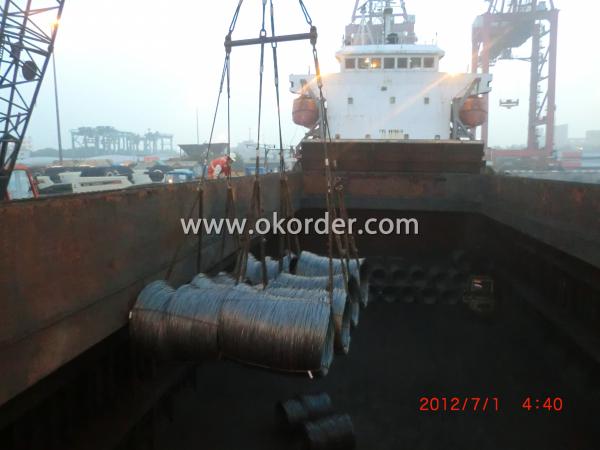
Carbon Steel Wire Rod in Container
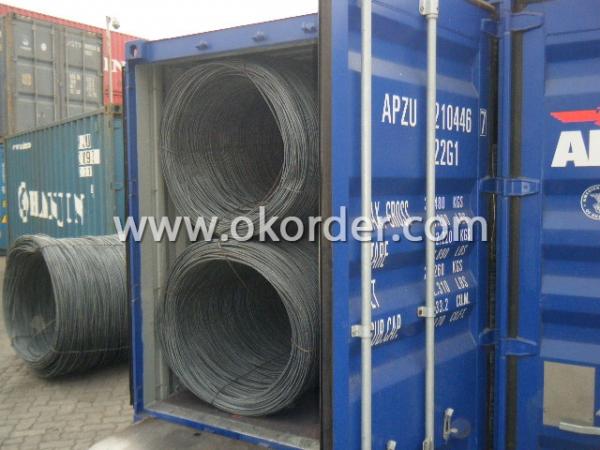
Note:
1. Our products are produced according to national standard (GB), if not, supply according to national standards (GB) or agreement as customer required.
2. Other Grade and Standard carbon steel wire rod we can supply:
Grade:H08A, 30MnSi, 62B-82B
Standard: AISI, BS, JIS, DIN
The Minimum Order Quantity of these products is high, and need to be confirmed.
3. We can not only supply carbon steel wire rod; if you need anything about building materials, please contact us.
4. Please send us your detail specifications when inquire. We will reply to you as soon as possible.We sincerely hope we can establish a long stable business relationship.
FAQ:
Q1: Can fit in the containers of Hot Rolled Steel Wire Rod SAE1008 for Making Wire and Nail?
A2: No problem, we can put them into the containers in the form sideling.
Q3: The products are invoicing on theoritical weight or on actual weight?
A3: We can do it in both manners, according to the customers' request.
Q3: What is the normal tolerance of Hot Rolled Steel Wire Rod SAE1008 for Making Wire and Nail?
A3: Normally 3%-5%, but we can also produce the goods according to the customers' requests.
- Q: What are the growth prospects for the steel wire rod market?
- The growth prospects for the steel wire rod market are promising due to increasing demand from various industries such as construction, automotive, and manufacturing. Additionally, the growing use of steel wire rods in infrastructure development projects and the rising trend of electric vehicles are expected to further drive market growth.
- Q: What are the different types of steel wire rod surface cleaning processes?
- There are several different types of steel wire rod surface cleaning processes, including mechanical cleaning methods such as shot blasting and wire brushing, chemical cleaning methods like pickling and phosphating, and thermal cleaning methods such as flame or plasma cleaning. Each process has its own advantages and is used based on the specific requirements and desired outcome for the steel wire rod surface.
- Q: What are the common inspection methods for steel wire rod?
- The common inspection methods for steel wire rod include visual inspection, dimensional measurement, mechanical testing, and non-destructive testing. Visual inspection is done to check for surface defects such as cracks, scratches, and corrosion. Dimensional measurement ensures that the wire rod meets the required specifications for diameter, length, and straightness. Mechanical testing involves conducting tensile, hardness, and impact tests to evaluate the strength, ductility, and toughness of the wire rod. Non-destructive testing methods like ultrasonic testing and magnetic particle inspection are used to detect internal defects or discontinuities without damaging the wire rod.
- Q: How does the corrosion resistance of steel wire rod vary with different surface treatments?
- Different surface treatments can greatly affect the corrosion resistance of steel wire rod. These treatments are used to improve the wire rod's ability to withstand corrosion and extend its lifespan. One common treatment for steel wire rod is galvanization, which involves applying a layer of zinc to the surface. This zinc coating acts as a sacrificial barrier, protecting the steel underneath from corrosion. Galvanized steel wire rod offers excellent corrosion resistance and can endure harsh conditions like high humidity or corrosive chemicals. Phosphating is another treatment option for steel wire rod. It entails applying a phosphate coating to the surface, enhancing its resistance to corrosion. This coating forms a protective layer, preventing rust formation and halting the spread of corrosion. Furthermore, steel wire rod can be coated with various substances, such as epoxy or polymers, to provide an additional layer of defense against corrosion. These coatings act as barriers, preventing moisture and corrosive substances from reaching the steel surface. Coated steel wire rod exhibits improved corrosion resistance and can be used in environments where direct exposure to moisture or corrosive agents is expected. It is important to note that the effectiveness of surface treatments in enhancing corrosion resistance can vary depending on specific conditions and the quality of the treatment. Factors like coating thickness and adhesion, presence of defects or impurities, and the type and concentration of corrosive substances in the environment can all impact the corrosion resistance of steel wire rod. In conclusion, the corrosion resistance of steel wire rod can be significantly improved through surface treatments like galvanization, phosphating, or the application of coatings. These treatments create protective barriers that ensure the wire rod's longevity and durability in different environments.
- Q: How is steel wire rod stored and handled to prevent damage?
- Steel wire rod is typically stored and handled with utmost care to prevent any damage. It is usually stored in a well-organized manner, with proper spacing between the rods to avoid tangling or entanglement. Additionally, the rods are often stored in a dry and covered area to protect them from moisture and corrosion. When handling steel wire rod, workers use appropriate lifting equipment that ensures a secure grip without causing any bending or distortion. By following these precautions, the risk of damage to the steel wire rod is minimized, ensuring its quality and integrity.
- Q: How is steel wire rod used in the manufacturing of wire mesh sieves?
- Steel wire rod is used in the manufacturing of wire mesh sieves as it serves as the raw material for forming the wire mesh. The steel wire rod is first drawn or stretched to the desired thickness and then woven or welded together to create the mesh pattern. This process ensures the strength, durability, and uniformity of the wire mesh sieves, making them suitable for a wide range of applications such as filtration, grading, and particle size analysis.
- Q: How is steel wire rod used in the production of springs?
- Steel wire rod is used in the production of springs as it is the primary material used to manufacture the spring itself. The wire rod is first drawn into the desired diameter and then coiled or shaped into the spring form. The high tensile strength and durability of steel make it ideal for withstanding the repeated compression and extension forces that springs endure.
- Q: What are the different types of steel wire rod surface defect evaluation and acceptance criteria?
- There are several types of steel wire rod surface defect evaluation and acceptance criteria, including visual inspection, dimensional measurements, and various non-destructive testing methods. The acceptance criteria are usually determined based on industry standards and customer specifications, considering factors such as the size, shape, and severity of surface defects. These criteria help ensure the quality and safety of steel wire rods for their intended applications.
- Q: How is the steel wire rod industry regulated?
- The steel wire rod industry is regulated through a combination of government regulations and industry standards. Governments typically set regulations on areas such as product quality, safety standards, environmental impact, and labor practices. These regulations ensure that the industry operates within certain parameters to protect the interests of consumers, workers, and the environment. Additionally, industry standards and certifications are often established by professional associations or organizations to further regulate and ensure the quality and safety of steel wire rod products.
- Q: How is the steel wire rod market affected by technological advancements?
- Technological advancements have a significant impact on the steel wire rod market. These advancements have revolutionized the production process, resulting in increased efficiency, improved quality, and reduced costs. One of the key technological advancements that have influenced the steel wire rod market is automation. Automation has made the production process faster and more precise, reducing the reliance on manual labor and increasing overall productivity. This has led to increased production capacity and reduced lead times, allowing manufacturers to meet growing market demands. Furthermore, advancements in metallurgy and material science have led to the development of high-performance steel wire rods. These rods possess superior strength, durability, and flexibility properties, making them suitable for a wide range of applications. Technological advancements have enabled manufacturers to produce steel wire rods with precise chemical compositions and microstructures, resulting in improved mechanical properties and enhanced performance. Moreover, technological advancements have also facilitated the development of advanced testing and quality control methods. Manufacturers can now employ non-destructive testing techniques, such as ultrasonic testing and magnetic particle inspection, to ensure the quality and integrity of steel wire rods. These advancements have significantly reduced the risk of defects and failures, resulting in increased customer satisfaction and trust in the market. In addition, technology has also had a positive impact on the distribution and marketing of steel wire rods. E-commerce platforms and digital marketing strategies have made it easier for manufacturers to reach a wider customer base and promote their products globally. This has increased market competitiveness and facilitated the growth of the steel wire rod market. Overall, technological advancements have revolutionized the steel wire rod market by improving production processes, enhancing product quality, reducing costs, and enabling effective distribution and marketing strategies. As technology continues to advance, it is expected that the steel wire rod market will continue to benefit from further innovations, ensuring its sustained growth and competitiveness in the future.
Send your message to us
Hot Rolled Steel Wire Rod SAE1008 for Making Wire and Nail
- Loading Port:
- Tianjin
- Payment Terms:
- TT or LC
- Min Order Qty:
- 25 m.t.
- Supply Capability:
- 200000 m.t./month
OKorder Service Pledge
OKorder Financial Service
Similar products
Hot products
Hot Searches
Related keywords










